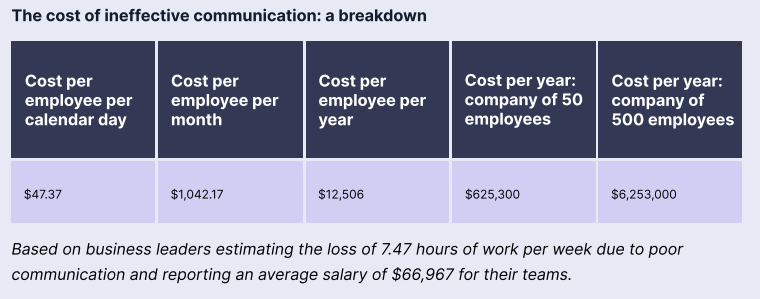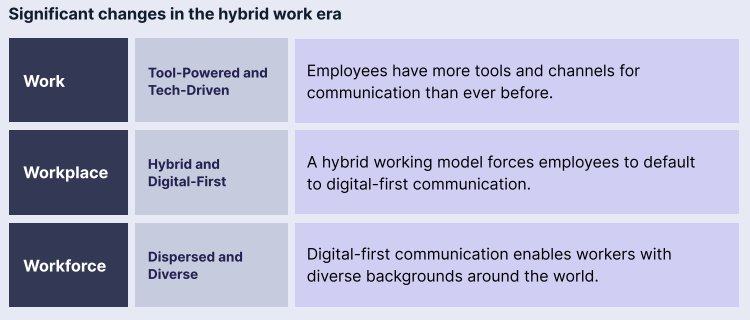Poor Communication is Co$ting Your Business... A LOT

"What is getting in the way of collaboration, productivity, and employee experience in the hybrid work era?"
That's the BIG question Harris Poll asked for Grammarly's recent The State of Business Communication survey. Their goal, after speaking with 1,252 business leaders and knowledge workers in the U.S, was to reveal what's impeding our ability to effectively connect, collaborate, and get work done in our now-hybrid world of work. To discover the real cost of poor communication in the workplace.
"Yes sir, we've got Trouble...with a capital T"
Unsuccessful communication methods and practices cost U.S. businesses $1.2 trillion (yes, you read that right...TRILLION with a capital T) per year.
True, 93% of business leaders agree that “communication is the backbone of business” and 96% believe “effective communication is essential for delivering the business results expected of my team in the coming year”.
Yet, we're left with the rather obvious question here:
If effective communication is that essential, why are you still losing trillions of dollars to poor communication each year?
Let's Get Real
If, like 73% of knowledge workers and 82% of leaders, your immediate response was "well, that's not me or my team - we communicate effectively", the results tell a different story...
Your people spend almost half of their time (approximately 26 hours) during the week collaborating with others either verbally or in written communications, including within their team, with leadership, and with your clients. Clear, concise, and effective communication is vital for these interactions to be successful. Yet, a majority of knowledge workers (86%) reported having experienced communication breakdowns and challenges due to issues such as:
- Not receiving timely responses from others (49%)
- Communicating clearly so receivers understand the message (37%)
- Understanding messages received from others (33%)
And the numbers aren't necessarily better for your hand-picked leaders.
The amount of time business leaders spend communicating is even greater: over 36 hours per week. This includes virtual meetings (5.82 hours), in-person meetings (5.23), and project or sales management software (5.06).
But, about 3 in 4 leaders (72%) and almost half of workers (45%) admitted their "team struggles to communicate clearly and consistently". In fact, leaders estimate their teams lose an average of 7.47 hours per week (about 19% of a 40 hr. week, or one entire workday) to poor communication.
The Costs of Poor Communication
While many of us may sometimes gripe about the “meeting that could have been an email” or joke with our colleagues that “that’s an hour of my life I can’t get back”, there are real and, quite frankly, painful costs to poor communication tools, practices, and principles at work (and in life, too, but that’s a topic for another day…).
Ineffective communication can not only impact how well employees and leaders collaborate, connect, and work through obstacles, it’s dipping deep into your business bank account…to the cost of about $12,506 per employee per year (based on average salary and communication failure estimates). That’s almost 20% of their salary!
And, it’s not just your knowledge workers who encounter these communication roadblocks. Three in four leaders agreed that “my team spends too much time and energy resolving miscommunications” (76%) and “I spend too much time and energy resolving miscommunications” (75%).
90% of them also reported feeling the pangs of poor communication, including increased costs (45%), missed deadlines or increased time to resolution (39%), and eroded brand credibility or reputation (34%).
In addition to the internal costs, 1 in 5 leaders (22%) reported a loss of business due to poor communication, with 86% citing the business value lost $10,000 or more and 22% losing $50,000 or more.
The Other Not-So-Obvious Costs of Poor Communication
While there are those direct, more quantitative numbers around the cost of poor communication, there are also several qualitative impacts that are seen (and heard).
- 90% of workers and 96% of leaders noted that poor communication negatively impacts their team, productivity, morale, and growth
- 87% of leaders felt that "my team will not be able to goals without effective communication skills"
- An increase in stress and burnout was cited as the top impact of poor communication
- Almost 100% of both leaders and workers agreed that "it makes my job easier when my colleagues communicate clearly"
So, Now What?
With nearly three-quarters of business leaders stating “My company underestimates the cost of poor communication” and “My company undervalues the impact of strong communication”, our question to you is…how valuable is effective communication to YOU and YOUR business?
86% of the leaders surveyed indicated they have or were planning on investing in improving their communication tools or strategies. Are you? And if so, how?
The hybrid models of work (mix of on-site, remote, synchronous, and asynchronous) are most likely here to stay, with 9 in 10 executives in a recent McKinsey & Company study citing the model (in some variation and depth) as to where they see their organization heading (unless your name is Elon...). This introduces new opportunities, as well as challenges. While where work is performed may be different, teams must still be able to effectively collaborate, stay connected, creatively problem-solve, and keep progress moving forward. This requires attention and intention around setting communication principles and practices. As the survey so wonderfully states, “Work no longer takes place 100% in the office—but your teams still need to communicate 100% of the time.”
While, in our now digital-first age, the solutions explored seemed to often start with a technology tool, the reality is all the tech in the world won’t solve fundamental communication problems like misunderstanding, misinterpretation, misaligned language and messaging, insufficient preparation, and poor listening. This means focusing first on People Tools & Principles before you introduce process and system solutions. It’s training your leaders and workers on how to effectively, efficiently, confidently, and mindfully communicate.
- To have the emotional intelligence and awareness of message tone, audience, and delivery
- To embrace healthy conflict in order to challenge stale habits and methods and craft new, innovative solutions to the needs of your business and those you serve
- To manage stress in order to prevent emotionally-charged, energy-depleted IDGAF message delivery
- To better prepare for the critical and tough conversations, meetings, and decisions necessary to move your business forward
The increase in remote and hybrid work environments did not create poor communication, it simply helped shine a light on and expose the realities of an already-struggling collaboration barrier. Over the last few years, and for the foreseeable future, you will be investing in new tools, new technologies, and new ways of doing business and supporting your teams. As part of your communication strategy, don’t forget to spend a little time getting the fundamentals of good communication right before you launch yet another chat tool, video meeting platform, or collaboration system.
Your People, Your Processes, and Your Profits will thank you.






